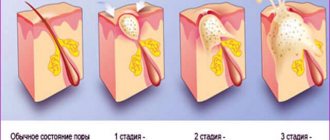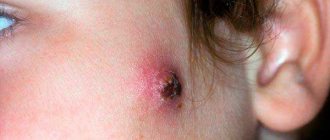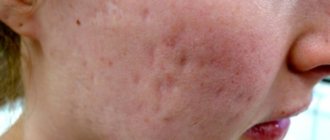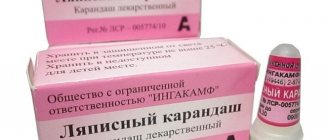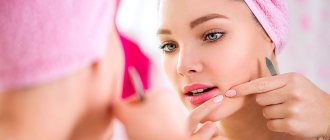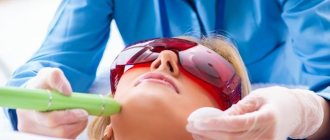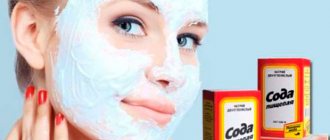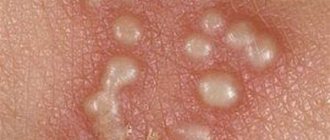Pregnancy is one of the best periods in a woman’s life, but even it is often complicated by problems. The first thing that comes to mind is changes in appearance, including weight gain, brittle nails, and changes in skin color. We will tell you how to get rid of pigmentation on the face after childbirth and prevent it from becoming chronic.
To do this, you can use pharmaceutical products, store-bought or do it yourself, but you should not neglect the advice of specialists - it is better to consult a doctor before self-medication.
Causes of pigmentation on the face after and during childbirth
Pigmentation after childbirth worries many women - after all, you want to remain beautiful even after the birth of a child. It consists of brown spots of various shapes, located on any part of the skin - on the face, stomach, neck, arms, anywhere. The intensity of the brown shade depends on the level of melanin. Most often, spots after and during pregnancy are located on the face and are mixed in appearance with healthy skin. This phenomenon is called the “pregnant mask”.
The medical name for the disease is chloasma, and it can occur for a number of reasons: due to excessive exposure to the sun, aging skin, or hormonal changes in the body due to pregnancy and birth of a baby. Treatment of each type is complicated by its own difficulties. How to get rid of pigmentation after pregnancy?
Postpartum pigmentation on the face can also cause serious problems in the body associated with disruption of the liver, thyroid gland, gallbladder and kidneys. If left untreated, the chronic stage may worsen, so consulting a doctor is mandatory.
Why pigmentation on the face occurs after childbirth and how you can get rid of it, you will find out below.
We recommend trying to remove age spots at home yourself.
Whitening cream consists of ingredients:
- 1 part honey;
- 1 part castor oil;
- 1/2 part Vaseline;
- A couple of drops of iodine.
Add iodine to the bottom of a clean (preferably glass) container, and then mix the remaining ingredients.
Use only a couple of times a week. The skin tightens, becomes elastic, chloasma - spots and freckles - disappear. Masks made from lemon and starch, and fresh parsley juice will help get rid of increased pigmentation. Masks made from fermented milk products are good at lightening pigmentation: kefir, sour cream or yogurt. Fresh cucumber, viburnum juice, calendula, grapefruit, pomegranate, elderberry, as well as cosmetic clay help well in the fight against pigmentation.
As you can see, the arsenal is large; all of the above home remedies will eliminate or significantly lighten the face and other problem areas from increased pigmentation. However, do not neglect the help of a dermatologist and other specialists who will help you restore your healthy and thriving appearance.
Or chloasma usually occurs between the fourth and sixth months. The face is most susceptible to pigmentation: spots appear on the forehead and temples, as well as around the mouth. This feature of the location of the spots gave rise to a special term called “mask of pregnancy.” Pigmentation is more pronounced in brunettes, although blondes are often susceptible to chloasma. The cause of hyperpigmentation of the skin in most cases is exposure to ultraviolet radiation. Expectant mothers spend too much time in the sun without protecting their faces from direct rays, thereby provoking the appearance of chloasma. The second most likely reason is a change in the body's hormonal levels. Often both of these factors are interrelated.
Before you begin self-treatment of age spots, visit a doctor to rule out possible diseases of the genital organs, malfunctions of the liver and adrenal glands, as well as a lack of folic acid in the body.
For those young mothers who want quick results, we can recommend peeling with fruit acids, phototherapy and cryotherapy. These procedures are highly effective and give quick results.
Prevention of skin pigmentation
It is impossible to accurately predict its occurrence or prevent its occurrence, but it is possible to reduce the intensity of its manifestations. So, during pregnancy you should not use:
- Essential oils, including photosensitive ones - lemon, orange, grapefruit and any other citrus. They make the skin more sensitive to light, which leads to the appearance of age spots.
- Fruit acids, or AHA acids. Despite their certainly amazing effect on the quality of the skin, they make it more sensitive to the sun, which without proper sunscreen with SPF of at least 30 leads to irritation and dryness.
Attention! The first and second points are also not advisable for use, not only because of the possible development of pigmentation, but also simply because this care is too aggressive for a pregnant woman - the child may develop allergies.
You should also avoid aggressive scrubs and use only rollers for peelings. After pregnancy, oils and AHA acids can be used, but it’s better to remove scrubs from the bathroom shelves forever - they are already aggressive.
Timely use of a cream or oil with a good SPF factor (from 15 depending on skin color - the lighter it is, the higher the factor up to 50 inclusive) can reduce the likelihood of age spots appearing in general, not only in the postpartum period.
It is recommended for pregnant women to sunbathe before 11 am or after 4 pm, since the sun is most active between these two hours and can cause not only spots, but also burns.
A balanced diet will also help keep the skin light - vitamins B, E and C take care of it, accelerate regeneration, healing and generally make the skin more elastic and smooth.
We suggest looking at the reasons for the appearance of age spots:
Factors that increase the risk of developing pigmentation
The likelihood of pigment spots appearing after childbirth increases due to a number of reasons.
The main ones:
- constant stress that has a bad effect on metabolism;
- lack of vitamins (especially folic acid);
- prolonged exposure to the sun;
- gastrointestinal diseases;
- thyroid diseases.
Heredity plays a big role. The predisposition to pigmentation is transmitted at the genetic level. It is enough to look at photos of mothers and grandmothers to predict the manifestation of postpartum spots in yourself.
When will pigmentation go away after childbirth?
Many mothers are concerned about the question: does labor pigmentation go away at all? As a rule, it goes away on its own after a few months, but can remain for life if appropriate measures are not taken in time.
How long will it take for pigmentation to go away after childbirth if it has become more complicated due to hormonal imbalances in the body or any diseases? It is impossible to determine exact numbers, only doctors can do this - you should first visit a dermatologist, and then, based on his assumptions and advice, go to an endocrinologist, gynecologist or gastroenterologist to clarify the diagnosis.
Locations of hyperpigmentation
Chloasma likes to be located in prominent places: on the forehead, bridge of the nose, upper lip, cheeks, and area around the eyes.
Less commonly appears on the skin of the inner thighs, chest, and abdomen.
The face of a woman in the pigmentation position is covered with a “mask”, which starts from the forehead, goes down the temples, covers the chin, cheeks and areas of the epidermis above the upper lip.
The most reliable remedies against illness
Some particularly brave wives decide to remove pigmentation on their face after childbirth with the help of surgery - they turn to a cosmetologist for laser resurfacing. This is an effective method, but it is not suitable for everyone - you need to ask your dermatologist and cosmetologist whether this method is suitable specifically for your skin.
After pregnancy, chemical peeling with acids can already be used - due to the action of AHA acids, the upper stratum corneum of the skin dissolves, old brown skin cells disappear, and new ones replace them. Peeling will help if you need cosmetic intervention in order to get rid of old cells left over from pregnancy; it will also not help with illnesses.
It should also be understood that pigment spots in the event of serious damage to any body systems will completely disappear only with complex use - you cannot get rid of them with creams or oils unless you take medications prescribed by a doctor. Unlike age-related pigmentation and those caused by sunburn, getting rid of pigmentation after childbirth on the face and body is a little more difficult, and getting rid of it requires an integrated approach.
The most popular means to get rid of the disease are pharmacy and homemade masks.
Contraindications to the use of anti-pigmentation products
In order not to harm yourself and your newborn baby, it is necessary to take into account some contraindications.
- Pigments should not be removed before the baby is 3 months old.
- Use medications only if the mother or child has no allergic diseases.
- It is contraindicated to use treatment products in the presence of inflammatory processes, open wounds, or rashes on the facial skin.
Pigment spots that appear after childbirth, in most cases, are not a pathological condition. If they do not go away for a long period, they itch, peel or bleed, you should go to see a doctor.
Pharmacy drugs
Treatment of pigmentation on the face during pregnancy or after childbirth is often carried out with medical products that can be purchased at the pharmacy. An integrated approach includes pharmaceutical preparations for cosmetic purposes, as well as tablets that can only be prescribed by a doctor.
Ampoules for mesotherapy are very popular. Since the classic version of this procedure involves inserting the drug, it is not recommended to do this at home - it is better to consult a cosmetologist. At home, you can buy a mesotherapy kit with a specialized massager and pamper yourself with a massage with a complex of active substances.
In the same way, you can buy serums with vitamin C, hyaluronic acid and collagen at the pharmacy and use them at night to avoid exposure to the active sun, and during the day use a cream with SPF of at least 30.
In pharmacies you can find whitening products labeled “Anti-pigmentation”, for example, creams, peels and clay masks called “White Linen” or “Achromin”.
The Russian line includes vitamin C, cucumber, green tea and flax extract and a small amount of fruit acids that can be used after the birth of a child - their concentration is so low. The line includes night and day cream, mousse, cream cocktail, tonic, clay masks (deep action with orange and bearberry extracts and a plasticizer mask with parsley), peeling, serum, local bleach and even a separate hand cream.
Attention! Despite the low content of fruit acids, sunbathing while using White Flax or going outside with it is not recommended for safety reasons. Based on this, you can safely cross the line’s day cream off your shopping list – you shouldn’t use it during the day anyway.
“Achromin” was known to our mothers for its whitening and at the same time protective effect. In addition, it moisturizes well, but is not suitable for those with oily skin - it is too thick and will clog pores.
Another popular remedy that reduces melanin production is the pharmaceutical Ayurvedic cream Clearvin. Since it does not contain acid and vitamin C, it can be used even during the day, even in summer with active sun. The whitening effect is achieved through a combination of plant, herbal and flower extracts. It also helps to resolve age spots and accelerate regeneration; it is used after operations, as it helps remove stitches and scars.
Also pay attention to the following:
- “Ideal Whitening” from Belita Vitex (tonic peeling and serum-corrector with acids);
- “Medoveya” from Natural Honey Product (cream with royal jelly and acids);
- Leniment balsamic ointment according to Vishnevsky (with birch tar);
- "Aevit" in the form of oil solutions or capsules (orally and a little on the skin at the same time).
How to get rid of pigmentation
Modern medicine and cosmetology are ready to provide a wide range of products and procedures to help cope with altered pigmentation. However, women during pregnancy and lactation should exercise increased caution. Any means can affect the health of the child, so it is necessary to consult a doctor in time, which will allow you to determine how to remove age spots on the face after childbirth.
Experts say that within several months (up to one year) after the birth of a child, a woman’s hormonal levels should return to normal. This phenomenon will also entail the return of the usual skin color.
If pigmentation does not disappear after childbirth, then this may indicate a chronic failure in melanin production, which requires additional intervention.
Most cosmetics and medicines that are used to lighten pigmentation contain:
- glycolic acid - most often used in whitening;
- tretinoin is a form of vitamin A (contraindicated during pregnancy);
- hydroquinone is a toxic substance (also contraindicated during pregnancy);
- ascorbic acid - vitamin C, used both in pure form and as part of creams, serums, masks, etc.
Below are cosmetics that have proven themselves in the fight for fair skin:
- Cream "Skinoren". This remedy is considered the most popular in the fight against postpartum spots. It effectively removes pigmentation, but does not have any additional effect on nearby tissues.
- The drug "Retin A". The product is available in the form of a cream, the main active ingredient of which is vitamin A. The action of the drug is aimed at gradually reducing the concentration of melanin. Used in courses.
- Cream "Achromin". Another effective remedy that makes pigmentation disappear, while providing a protective effect against ultraviolet rays.
- Complex of means "Uniton". This approach includes the use of gel, cream and serum, which are used alternately throughout the day. The main active ingredient of the drugs is hydroquinone, which reduces the natural production of melanin, reducing the intensity with which pigmentation appears.
It is contraindicated to exceed the recommended dosage; this may make the skin too sensitive to sunlight, which will only harm it. During lactation, it is important to remember that the active ingredients of creams and ointments can pass into breast milk.
Above are the most common products that are used in cosmetology and are also approved by doctors. It is not recommended to deal with pigmentation on your own; only a doctor can fully assess a woman’s health and select the right medications.
In addition to the topical products discussed above, women often go to beauty salons for special procedures. Most often, this approach is justified if the pigmentation has not disappeared and creams have not helped.
Common salon procedures that allow you to quickly see a positive effect:
- mesotherapy - intradermal injection of a special amino acid into the affected areas, which will effectively combat altered pigmentation;
- laser treatment, which consists of polishing pigmented areas and removing rough layers of the epidermis;
- a method of light therapy, which involves exposing the skin to special light waves, they help remove and destroy excess melanin;
- Chemical peeling is the harshest and most radical way to get rid of skin problems; it requires a careful approach to the use of acid-containing substances.
The number of procedures is always determined individually, taking into account the woman’s health condition.
For all these methods, pregnancy is a contraindication!
It is important to fight not only for your own beauty, but also for the health of your child. If there are contraindications to the procedures, the cosmetologist should advise alternative approaches.
A woman after childbirth should not forget that some procedures can be hazardous to health, then she will have to completely forget about hardware approaches in cosmetology until the end of the lactation period.
If the financial situation does not allow you to seek help from expensive cosmetic procedures, then homemade folk recipes, the effectiveness of which has been proven by time, come to support.
Among the popular recipes, there are several available at home:
- Cucumber mask. Just grate the cucumber on a fine grater and apply an even layer on your face. This procedure is carried out for half an hour, after which the mask is washed off with cool water.
- Regular parsley effectively improves skin condition. It is enough to pour boiling water over a bunch of greenery so as to completely cover the leaves. Leave to brew for about half an hour, then filter, add a little lemon juice and freeze in ice cube trays. Regularly take out a cube of frozen broth and wipe your face with it (morning and evening after cleansing).
- It is recommended to brew dandelion flowers in a similar way. The decoction is also frozen and used in portions in the morning and evening.
- You can also squeeze lemon juice onto a cotton pad and wipe your face with it morning and evening instead of toner,
- Grate raw potatoes on a coarse grater and apply a thick layer to your face, leave for an hour, then rinse with water. The procedure is carried out at night.
The use of traditional medicine recipes is popular among women during pregnancy and lactation. This is explained by the fact that only natural ingredients are used during the procedures.
During pregnancy, enormous changes occur in a woman’s body: hormonal disruption, restructuring of the functioning of internal organs.
All this affects the emotional and physiological state of the expectant mother. When there is a change in skin color in certain areas of the skin, we talk about pigmentation during pregnancy.
Home Recipes
It is also possible to remove postpartum pigmentation on the face at home with an integrated approach and a not very severe stage of the disease.
Since you can use essential oils after pregnancy, arm yourself with orange, lemon or some other citrus oil, jojoba or almond oil and clay. Clay can be taken in any color, but black, white and green are the most effective. Take 2 tablespoons of clay, add water to it until it becomes a thin cream, 5-7 drops of base oil, 3-4 drops of essential oil, mix thoroughly and apply to the face. Leave for 10-15 minutes; when it starts to dry out, sprinkle with thermal or regular water.
Using only aspirin tablets (2-3) and water, you can make your own acid peeling, mask or serum, which will be no less effective, but safer - the acid here is salicylic, which is not related to AHA acids.
Also don't forget about lemon juice, which can be mixed in a 1:2 ratio with water and used as a lotion at night.
What does chloasma look like?
Bright pigmentation appears on a small area of the epidermis. Its borders are expressive, but uneven and do not rise above the skin.
Chloasma can be colored in various shades of brown: light brown, yellowish, dark brown, brown.
Their sizes vary. In some people the spot is less than 1 cm in diameter, in others the disease spreads to many parts of the face.
Review of real reviews
Apparently, many girls with prolonged pigmentation after childbirth only needed to push the melanin-colored cells to break down - when they started using White Flax peeling or clay masks, the spots went away. In this case, spots were not a problem, and creams with fruit acids helped to maintain good skin condition.
But those who got rid of pigmentation on the face after childbirth with the help of medical means - chemical peeling, mesotherapy, laser cleaning, note that cosmetics did not help them get rid of the disease, and to keep their face in order they use professional dermatological rulers.
Methods of disposal
In order not to provoke the formation of age spots, you should follow some rules:
- Limit exposure to the sun during the period of active ultraviolet action.
- Use sunscreens with maximum performance.
- The diet should contain foods high in polyunsaturated fatty acids (omega-3): vegetable oils, fish, walnuts.
You should not rush to radically get rid of age spots on your face, as they will go away on their own without leaving a trace.
A woman’s hormonal status returns to normal 1-2 months after the cessation of lactation, when the menstrual cycle is restored . In the postpartum period, the skin on the abdomen first begins to clear of pigmentation, then the color on the nipples fades and, last of all, on the face. Until the cause (hormonal changes) is eliminated, no, even ultra-modern, whitening methods will be able to completely cope with the problem.
It is possible to remove pigment spots on the face using whitening and exfoliating creams, ointments and gels, hardware methods (laser, photo-, mesotherapy) in beauty salons or at home using folk methods.
Pharmacy products
Before using any cosmetic products, the individual sensitivity of the body to certain components included in the cream is checked. To do this, a skin test is performed: a small amount of the drug is applied to the inner surface of the forearm. If after 8 hours no redness appears on the skin, the cream can be used.
- Skinoren. The active ingredient is azelaic acid, which frees epithelial cells from excess pigment and improves metabolic processes. Do not allow the ointment to come into contact with the mucous membranes of the eyes and mouth.
- Melanativ is a multi-component whitening preparation. Use with caution because it may cause skin irritation.
- Idealia is produced by the Vichy cosmetics company. Use morning and evening, applying the cream to pigmented areas. Significant skin lightening will appear in 1-3 months. The composition does not contain aggressive substances.
- Evinal. Contains natural ingredients - extracts of parsley, calendula, placenta, corn oil and vitamin E. Allows you to remove pigmentation on the face and open areas of the body. Reduces skin sensitivity to ultraviolet radiation. Can be used simultaneously with sunscreens.
- Neotone - the action is to enhance exfoliation of the upper layer of the epidermis, which contains a lot of melanin in the cells. The horny layers soften, as a result, conditions are created for replacing old dead cells with new young ones.
We recommend reading: Bandage after childbirth: types, how to put on, how long to wear
Cosmetic procedures
If more than a year has passed after giving birth, and pigment spots continue to remain, it is necessary to consult with specialists (therapist, dermatologist, endocrinologist, cosmetologist) to find out the causes, as well as select means and methods to eliminate this defect. The conditions for the procedures are the absence of acute diseases and inflammatory processes on the skin . Contraindications: periods of pregnancy and lactation.
- Laser resurfacing. The laser beam removes the upper layer of the epidermis along with the melanin it contains. Cells of the germ layer actively divide to restore the integumentary tissue without areas of increased pigmentation. It must be taken into account that after laser resurfacing, restoration of the skin in the area affected by the beam occurs after 2-4 weeks.
- Phototherapy. This is a method of exposure to light waves of different lengths: infrared or ultraviolet spectrum. When the skin absorbs light rays, melanin is destroyed and spots disappear. The surrounding tissues are not affected. The irradiated area of the epidermis gradually peels off, and the new layer that forms in its place has the appearance of normally colored skin. The number of courses varies and depends on the individual characteristics of the patient’s skin. On average, 3-10 manipulations are needed to completely clear hyperpigmentation. They are carried out at intervals of 2-3 weeks.
- Mesotherapy. The essence of the procedure is the introduction of various biologically active substances directly into problem areas. The advantage of this method is that ointments act only on the surface of the skin, and with mesotherapy, medicinal preparations are delivered to the middle layers of the skin using thin long needles. This allows you to remove pigment spots as a result of intracellular destruction of melanin in tissues with excess melanin content.
- Microdermabrasion. This is a mechanical method of removing pigmentation on the skin using microcrystals. There is a detachment of the upper dead layers of the epidermis and increased regeneration of new cells. For a good effect, it is necessary to cleanse the skin of pigment 5-6 times.
- Chemical peeling. You can remove brown stains using chemicals. The method involves exposing the upper layer of the epidermis to organic acids, causing a slight burn. Getting rid of pigmentation using chemical peeling is contraindicated for very dark-skinned people, since after the procedure, skin cells may lose the ability to synthesize and accumulate melanin.
Folk remedies
The lightening properties of fruits and vegetables are determined by the presence of fruit acids in them. The main mechanism of action is exfoliation, cell stimulation, improved metabolism, and the ability to whiten and moisturize the skin.
Folk remedies work gently, so it takes a long time to remove age spots. But their use is harmless, unlike aggressive drugs containing hydroquinone and arbutin, which can quickly remove stains, but they are very toxic and often cause allergic reactions.
Rubbing the pigmented areas with ice cubes made from berry or vegetable juices is useful.
Tonics
- Add a tablespoon of chopped parsley to a glass of boiling water. Leave for 3 hours. Mix the juice of one lemon into the infusion, pour the mixture into an ice-making container, and freeze. Rub ice cubes onto your face several times a day.
- Add 10 ml of alcohol to 30 ml of fresh natural milk. Apply the resulting mixture to problem areas of the skin overnight.
Masks
Almost any fruit or vegetable can be used to get rid of excess pigmentation at home.
- Masks made from natural yogurt, yogurt, kefir, cottage cheese. The dairy product is mixed with cucumber puree or lemon pulp in equal parts. Apply the mask to a clean face and wash off with warm water after 15 minutes.
- Combine 25 g of yeast, 5 ml of lemon juice, 25 ml of fresh milk. Apply gauze soaked in this mixture to your face for 15 minutes.
- Chop a medium fresh cucumber, add 25 ml of olive oil and lemon juice. Leave on the skin for 10-12 minutes.
Applications
- Mix 80 ml of kefir with 40 ml of tomato juice. Soak gauze in the mixture and apply to the stains for 15 minutes.
- Chop the washed potatoes. Apply the resulting paste in a thin layer to your face. After 15 minutes, wash your face.
Lotions
- Pour 50 g of chopped parsley roots with a liter of alcohol. Leave in a dark place for about 2 weeks. Wipe problem areas daily.
- Brew 50 g of viburnum fruit with a glass of boiling water. After an hour, strain, moisten a napkin, and apply to the face for 10 minutes. Perform the manipulation 3 times.
It is understandable that every woman wants to be beautiful and well-groomed at all times, and especially during that happy time when she is carrying a child. But don’t be upset about the appearance of age spots; they will go away on their own some time after birth.
Parsley infusion
Pour 100 grams of parsley into 170 ml of boiling water and leave the mixture for an hour. After this, wipe your face with the resulting lotion 2-3 times a day.
Salon treatments for facial pigmentation
A pigment spot can appear for various reasons. Based on them, the doctor will recommend hardware options for combating it. Usually it doesn’t come to salon procedures, since spots after pregnancy are superficial. However, there are exceptions.
Mesotherapy
Injection of drugs under the skin and stimulation of active points. Components fight pigmentation due to the main powerful antioxidant, which brightens and activates collagen synthesis. They also contain biomimetic peptides that reduce melanin synthesis.
Laser resurfacing
The shell conducts a laser through itself, which heats up at the site of the rash and the formation evaporates. Good effect on freckles. Polishing is effective, but the number of sessions is determined by the doctor. The main thing is not to overdo it, otherwise a burn may appear and the pigmentation will return again.
Phototherapy
A modern way to permanently get rid of skin pigmentation. The result is visible to the naked eye after the first manipulation. The point is that the doctor uses a flash to heat the pigment, which leads to its destruction and peeling.
The advantages include high efficiency, safety and harmlessness. The risk of damage to healthy tissue is reduced to zero. There is no rehabilitation period, scars after removal.
Contraindications: high skin sensitivity, herpes, dermatological pathologies, diabetes mellitus type 1 or 2, bleeding disorders, scars in the treatment area.
We recommend reading: Disposable panties for maternity hospital, their pros and cons, sizes
Chemical peeling
This manipulation has found wide application in modern cosmetology practice. And many doctors, when asked how to remove stains, recommend exposure to chemicals to their patients.
There are three types:
- Superficial is the most gentle form. It will take from 4 to 10 procedures with an interval of 10 days;
- The middle one is a more effective option. The result can be seen after the first procedure. Perform once every 30 days.
- In-depth treatment is allowed only once every 6 months.
Important: in women with hypersensitive skin, blisters and scars appear after the procedure.
Reasons for appearance
In mothers, this is associated with an increase in the growth of certain hormones and a decrease in the amount of others.
If a pregnant woman's face is covered with red spots, then doctors call it chloasma of pregnancy. The main hormones that can cause dark spots on the face are progesterone and estrogen. This is a common occurrence especially in girls with dark hair. Lack of folic acid, which is responsible for the development of the immune and circulatory systems, causes the appearance of chloasma. Causes:
- A hormonal disorder in which melanin is distributed unevenly. Red, brown or light rashes appear in certain areas of the epidermis. Depends on the color of the dermis and the amount of melanin accumulated in it.
- Genetics. If one of your relatives had pigmentation, then perhaps it will overtake you too.
- UV rays.
- Stress. Nervous tension is harmful, especially for pregnant women.
- Lack of vitamins and microelements.
- Additional diseases of the thyroid gland or gastrointestinal tract.
How to influence the removal of a pigment stripe?
Since it is not possible to establish with absolute certainty when the stripe on the abdomen passes after childbirth, you can try to remove it. Of course, you should not be nervous or panic, because this can have a very detrimental effect on the health and nervous state of the child. The process of natural restoration of skin pigmentation may take a long time, but it will definitely complete on its own. But if you don't have the patience to wait for the line on your belly to go away after giving birth, this can be done with a little help. Today there are many lightening cosmetics and folk recipes that can contribute to this process.
When does the line on the stomach go away after childbirth? Each woman’s body is individual, so it is impossible to name the exact period during which it will pass. There are very effective natural methods, which, if used regularly, you can take it into your own hands and get rid of the disturbing factor. The most effective procedures include the following:
- carrying out home peeling with natural (required) honey;
- applying a mask of fresh grated cucumber to the affected area;
- using fresh grated parsley paste to lighten the skin;
- applying freshly squeezed lemon juice to the dark stripe;
- freezing cucumber-parsley juice and wiping problem areas with this ice;
- applying a curd mask;
- use of linden decoction with chamomile.
How to avoid the appearance of a pigment stripe on the stomach?
Every woman’s body is individual, and this is especially true during pregnancy and childbirth. A frightening brown stripe on the stomach after childbirth can appear in the twelfth week of pregnancy or in its last trimester. In the case of your first pregnancy, this mark may appear a little earlier and will be more noticeable. But there are ways in which this dubious decoration can be made less bright and noticeable. To do this, you just need to constantly monitor the level of melanin in the body and reduce its production. Excessive production of this hormone can be provoked by ordinary ultraviolet rays, which have a harmful effect on the delicate skin of a pregnant woman.
In order not to be tormented by the question of when the line on the stomach will go away after childbirth, it is better to resist this process immediately. The following precautions will help you avoid a clear manifestation of pigmentation on the abdomen:
- try to spend less time in open sunny space;
- use sunscreen or sprays;
- choose clothes with maximum coverage of the body, but from light fabrics;
- Avoid exposure to the sun from noon to sixteen hours, when ultraviolet levels are highest.
It is impossible to completely exclude the impact of sun rays on the body of mother and child, because they are the ones who synthesize vitamin D, which is important for their overall health. Sunbathing can and should be done, but only early in the morning or late in the evening.

